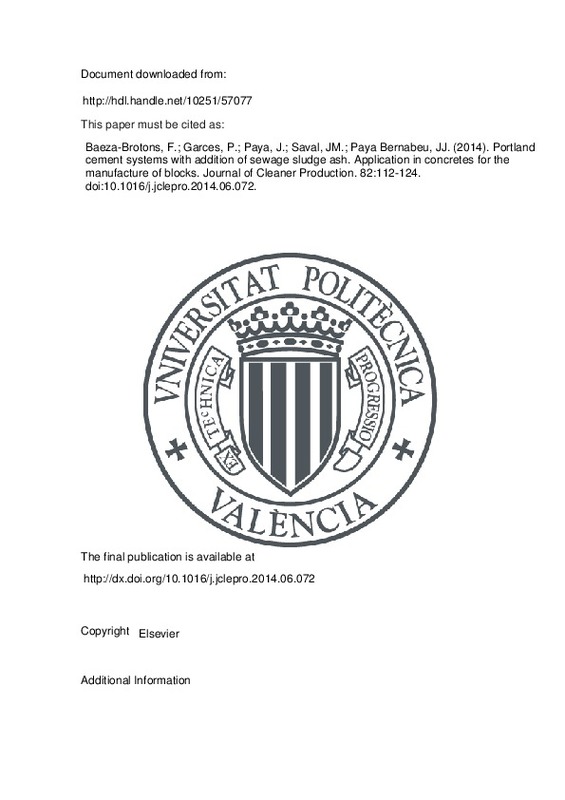JavaScript is disabled for your browser. Some features of this site may not work without it.
Buscar en RiuNet
Listar
Mi cuenta
Estadísticas
Ayuda RiuNet
Admin. UPV
Portland cement systems with addition of sewage sludge ash. Application in concretes for the manufacture of blocks
Mostrar el registro sencillo del ítem
Ficheros en el ítem
| dc.contributor.author | Baeza-Brotons, Francisco
|
es_ES |
| dc.contributor.author | Garces, Pedro
|
es_ES |
| dc.contributor.author | Paya, Jordi
|
es_ES |
| dc.contributor.author | Saval, José Miguel
|
es_ES |
| dc.date.accessioned | 2015-11-05T11:43:52Z | |
| dc.date.available | 2015-11-05T11:43:52Z | |
| dc.date.issued | 2014-11 | |
| dc.identifier.issn | 0959-6526 | |
| dc.identifier.uri | http://hdl.handle.net/10251/57077 | |
| dc.description.abstract | This study analyzes the viability of using sewage sludge ash (SSA) as a raw material in the composition of concrete, with a similar dosage to when it is used to manufacture blocks, therefore, with dry consistency given the type of the industrial process of these precast. These ashes are a serious problem, so their valorization in a sector like construction, with a high demand of resources, would be a great advantage from an economic and environmental perspective. A scale with the percentages of addition of ash in relation to cement (5, 10, 15 and 20%) was designed and the replacement of sand by this material, as well as the addition of an inert material such as marble dust. For a better understanding about how these mixtures behave in other cementitious systems, thermogravimetric analysis were performed on pastes with curing ages of 7, 28 and 90 d, and physical and mechanical tests on mortars cured for 28 and 90 d. It was proved that the addition of SSA in concrete used for manufacturing blocks cured for 28 d provided densities and resistances similar to the control sample (without SSA) and significantly reduces the water absorption. The replacement of sand by the mineral addition significantly improves the parameters mentioned above. | es_ES |
| dc.description.sponsorship | This research was financed by the University of Alicante through Projects VIGROB-256 and GRE10-28 and by Generalitat Valenciana through project GV/2012/113. | en_EN |
| dc.language | Inglés | es_ES |
| dc.publisher | Elsevier | es_ES |
| dc.relation.ispartof | Journal of Cleaner Production | es_ES |
| dc.rights | Reserva de todos los derechos | es_ES |
| dc.subject | Waste valorization | es_ES |
| dc.subject | Precast concrete block | es_ES |
| dc.subject | Block performance | es_ES |
| dc.subject | Paste | es_ES |
| dc.subject | Thermogravimetry | es_ES |
| dc.subject | Mortar | es_ES |
| dc.subject.classification | INGENIERIA DE LA CONSTRUCCION | es_ES |
| dc.title | Portland cement systems with addition of sewage sludge ash. Application in concretes for the manufacture of blocks | es_ES |
| dc.type | Artículo | es_ES |
| dc.identifier.doi | 10.1016/j.jclepro.2014.06.072 | |
| dc.relation.projectID | info:eu-repo/grantAgreement/GVA//GV%2F2012%2F113/ | |
| dc.relation.projectID | info:eu-repo/grantAgreement/UA//GRE10-28/ | |
| dc.relation.projectID | info:eu-repo/grantAgreement/UA//VIGROB-256/ | |
| dc.rights.accessRights | Abierto | es_ES |
| dc.contributor.affiliation | Universitat Politècnica de València. Departamento de Ingeniería de la Construcción y de Proyectos de Ingeniería Civil - Departament d'Enginyeria de la Construcció i de Projectes d'Enginyeria Civil | es_ES |
| dc.description.bibliographicCitation | Baeza-Brotons, F.; Garces, P.; Paya, J.; Saval, JM. (2014). Portland cement systems with addition of sewage sludge ash. Application in concretes for the manufacture of blocks. Journal of Cleaner Production. 82:112-124. doi:10.1016/j.jclepro.2014.06.072 | es_ES |
| dc.description.accrualMethod | S | es_ES |
| dc.relation.publisherversion | http://dx.doi.org/10.1016/j.jclepro.2014.06.072 | es_ES |
| dc.description.upvformatpinicio | 112 | es_ES |
| dc.description.upvformatpfin | 124 | es_ES |
| dc.type.version | info:eu-repo/semantics/publishedVersion | es_ES |
| dc.description.volume | 82 | es_ES |
| dc.relation.senia | 283299 | es_ES |
| dc.contributor.funder | Generalitat Valenciana | es_ES |
| dc.contributor.funder | Universitat d'Alacant | es_ES |







![[Cerrado]](/themes/UPV/images/candado.png)

